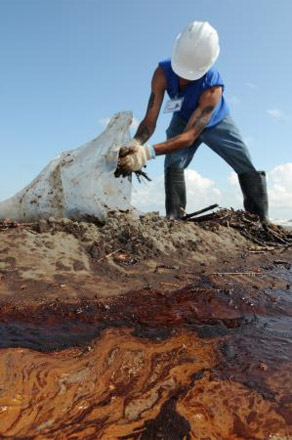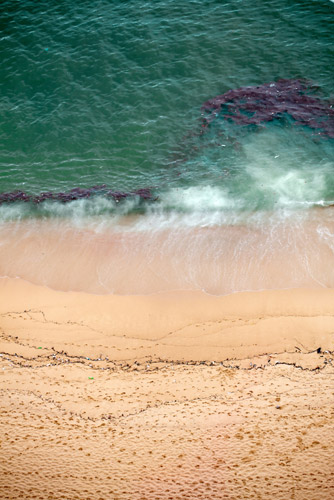Weston Solutions Deepwater Horizon Oil Spill From Challenge to Opportunity?
On April 20, 2010, an explosion occurred at the Deepwater Horizon drilling rig in the Gulf of Mexico 40 miles off the Louisiana shore. In addition to loss of life, the massive amount of crude oil leaking into the water would lead to human, economic and environmental disaster, sending shockwaves throughout the region’s natural systems and economy. Many thought this environmental disaster would forever change life in that corner of the world. Americans viewed images of oiled brown pelicans, dead sea turtles, bottlenose dolphins slipping through the oiled waters and the Gulf Coast’s sugar white sands and crystal blue waters stained with oil. People held their breath as attempts to cap the well took more than three months – bringing tears to their eyes and rocking their conscience on America’s oil dependence. And then there is still the spill’s unseen and unknown toll. The blowout in the Gulf forced the question, “Is it worth the risk?”1
How America and BP ultimately respond to this environmental disaster will define America’s future for the 21st Century.
On May 22, 2010, President Barack Obama announced the creation of the National Commission on the BP Deepwater Horizon Oil Spill and Offshore Drilling: an independent, nonpartisan entity directed to provide a thorough analysis and impartial judgment. The President charged the Commission to determine the causes of the disaster, to improve the country’s ability to respond to spills and to recommend reforms to make offshore energy production safer.
A month later, on June 15, 2010, Obama assigned Secretary of the Navy Ray Mabus the responsibility to lead the effort to create a plan of Federal support for the Gulf Coast region’s long-term economic and environmental restoration. Obama’s directions to Mabus regarding the plan were as follows:
- Develop a comprehensive assessment of post-spill needs and define Federal assistance on overall recovery;
- Develop an approach that will ensure economic recovery, community planning, science-based restoration of ecosystem and environment, public health and safety efforts and support of individuals and businesses that suffered losses due to the spill;
- Identify long and short-term objectives and how achievement of these objectives will be measured.
Three months later, in September 2010, Mabus released “America’s Gulf Coast: A Long Term Recovery Plan after the Deepwater Horizon Oil Spill.” The report recommended that the President urge Congress to dedicate a significant amount of any civil penalties obtained from parties responsible for the Deepwater Horizon oil spill into a Gulf Coast Recovery Fund to go toward addressing long-term recovery and restoration efforts in the Gulf. To manage the funds and to coordinate recovery projects, the Mabus report recommended Congress authorize a Gulf Coast Recovery Council.

Photo by Petty Officer 3rd Class Patrick Kelley
As designed, the Recovery Council would include representatives from the states and federally recognized Gulf tribes. The Recovery Council would work to ensure local governments and citizen stakeholders also played a critical role. In the interim, the report recommended the President establish the Gulf Coast Ecosystem Restoration Task Force. A bridge to the Recovery Council, this intergovernmental advisory body would coordinate restoration programs and projects in the Gulf region. On October 5, 2010, Obama created the Gulf Coast Ecosystem Restoration Task Force (GCERTF) and named Lisa Jackson, Secretary of the U.S. Environmental Protection Agency (EPA), Chair.2
In January 2011, the National Commission on the BP Deepwater Horizon Oil Spill and Offshore Drilling released their findings as follows: first and foremost, “The explosive loss of the Macondo well could have been prevented;” and second, “The immediate causes of the Macondo well blowout can be traced to a series of identifiable mistakes made by BP, Halliburton and Transocean that reveal such systematic failures in risk management that they place in doubt the safety culture of the entire industry.” The National Commission’s recommendations are numerous and grouped into seven distinct areas:
1-A. Improving the Safety of Offshore Operations,
2-B. Safeguarding the Environment,
3-C. Strengthening Oil Spill Response, Planning and Capacity,
4-D. Advancing Well-Containment Capabilities,
5-E. Overcoming the Impacts of the Deepwater Horizon Spill and Restoring the Gulf,
6-F. Ensuring Financial Responsibility, and
7-G. Promoting Congressional Engagement to Ensure Responsible Offshore Drilling.
Recommendation E5 states that Congress should dedicate 80 percent of the Clean Water Act penalties to support implementation of a region-wide Gulf of Mexico restoration strategy. Recommendation E6 states that Congress and federal and state agencies should build organizational, financial, scientific and public outreach capacities needed to put the restoration effort on a strong footing. The Commission then details the need for a joint state-federal Gulf Coast Ecosystem Restoration Council to implement the restoration strategy for the region, a Citizens Advisory Council and establishment of a Gulf Coast Ecosystem Restoration Science and Technology Program.3
In July 2011 legislation co-sponsored by all Gulf Coast Senators (Fla., Ala., Miss., La. and Texas) entitled, “Resources and Ecosystems Sustainability, Tourist Opportunities and Revived Economy of the Gulf Coast Act of 2011” (RESTORE the Gulf Coast Act of 2011) was introduced. This legislation would establish a Gulf Coast Restoration Trust Fund, which would credit to the Trust Fund amounts equal to 80 percent of all administrative and civil penalties paid by responsible parties in connection with the Deepwater Horizon oil spill. Funds would be expended in the five Gulf Coast States (Fla., Ala., Miss., La., and Texas) to restore and to protect the natural resources, ecosystems, fisheries, marine and wildlife habitats, coastal wetlands and economy of the Gulf Coast.
Funds would be distributed as follows: 35 percent allocated in equal shares to the five Gulf Coast States, 60 percent allocated to the Gulf Coast Ecosystem Restoration Council and 5 percent allocated to the Gulf science and fisheries program. Of the 60 percent going to the Gulf Coast Ecosystem Restoration Council one-half would be used for development and implementation of a comprehensive ecosystem restoration plan (in consultation with the Gulf Coast Ecosystem Restoration Task Force) and one-half would be allocated according to an impact driven formula and disbursed to the Gulf Coast States by the Council in response to plans submitted by the Gulf Coast States. To encourage large-scale projects, the bill would authorize the Gulf Coast state or coastal political subdivision to use money from this account to cover the non-Federal share of another federal program, which provides funding for projects that would restore and protect the natural resources, ecosystems, fisheries, marine and wildlife habitats, coastal wetlands or economy of the Gulf Coast states or coastal political subdivisions.

© iStockphoto.com/JodiJacobson
The legislation would establish the Gulf Coast Ecosystem Restoration Council, which would be comprised of eight Federal officials and five State officials and would be chaired by one of the members selected by the council. The Council would principally be tasked with developing a “Comprehensive Plan” to support projects and programs that would restore and protect the natural resources, ecosystems, fisheries, marine and wildlife habitats, and coastal wetlands of the Gulf Coast ecosystem. The Comprehensive Plan must prioritize the projects that have the greatest contribution to restoring and to protecting the Gulf Coast Ecosystem and that are contained in approved State comprehensive plans and large scale projects, as well as projects that restore resiliency of those resources most impacted by the Deepwater Horizon spill.
In September 2011, the bill passed the Senate Environment and Public Works Committee. The Senate leaders hope to bring the proposal before the full chamber for passage through the Senate by year’s end. On the House side, a bipartisan bill was introduced on October 5, 2011 – HR 3096, “Restore the Gulf Coast Act,” which is nearly identical to the Senate bill.
Also on October 5, 2011, the GCERTF released their preliminary Gulf of Mexico Regional Ecosystem Restoration Strategy for public review. The GCERTF reiterated recommendations made by Mabus that called for Congress to:
- Formalize the long-term intergovernmental partnership among the Gulf Coast states and federal government by establishing a successor coordinating body to the Gulf Coast Ecosystem Restoration Task Force, and
- Dedicate a significant portion of the eventual Clean Water Act civil penalties resulting from the Deepwater Horizon oil spill for Gulf recovery, in addition to current funding for Gulf programs.
The restoration strategy contains four overarching goals designed to guide the collective actions at the local, state and federal levels to restore the health of the Gulf of Mexico ecosystem: restore and conserve habitat, restore water quality, replenish and protect living coastal and marine resources and enhance community resilience. Each goal identifies a series of actions necessary to begin the restoration process. Several of the actions described in the GCERTF strategy can be immediately implemented by one or more members of the Task Force by ongoing plans and supporting programs. For actions not currently supported, the GCERTF intends to:
- Specify the current status of each issue, include which agency is working on the issue, under which authority and with what resources;
- Identify a lead agency, state or other actor for each task needed to implement the action, along with appropriate partners;
- Create a schedule of specific activities to accomplish each goal, along with any necessary or available resources, authority, science or external support needed;
- Establish a science-based approach for ensuring success of actions undertaken;
- Provide critical decision-support tools to reflect ecosystem trends over time, communicate progress of restoration projects, and inform critical decisions and necessary changes in restoration efforts;
- Continue to engage the public and communities;
- Establish and maintain the core interagency staff expertise needed to develop the implementation plan and guide its execution;
- Expand opportunities for collaboration with local governments, business entities and non-governmental organizations (NGOs)4.
All the efforts highlighted above (Mabus Report, National Commission Report to the President, Gulf of Mexico Regional Ecosystem Restoration Strategy) have undergone tremendous public and stakeholder involvement and input. Legislation is pending that would enable this explicit vision alignment amongst the public, stakeholders, tribes and government to become a reality. Meaningful change created by implementing an ecosystem restoration program for the Gulf of Mexico will take adaptive learning, high-quality connections, enterprise energy, explicit alignment and generative leadership.
Will America take a critical step forward and allocate the Clean Water Act fines toward the long-term restoration of the Gulf of Mexico? Will America take this unprecedented environmental disaster and make it about the greater good? This is a defining moment in U.S. history, which will impact generations to come. Leaving a legacy through leadership and partnership is possible and the moment is NOW!

© iStockphoto.com/michaelbwatkins | “The purpose of life is a life of purpose.” – Robert Burns




























